Aim and Scope Before the wide availability of
powerful and affordable computers, modeling covalent molecules and ionic
structures by researchers was primarily with physical models. Such
kits are still widely available primarily for students (see
review of some major makers in
refs.) but even in the educational role, software for many
reasons is becoming more dominant.
Vintage modeling systems by a
variety of makers are very collectable with some makers now
long gone*. Such systems when sold e.g. on
eBay or by auction houses do not always come with manuals and
brochures. The author has a small collection of these older
kits and has endeavoured to track down paper resources to
accompany them. The systems below give links to download pdf
copies of resources acquired
or to links where they are available online.
* The
definitive resource on these systems is Molecular and Crystal Structure Models by Anne Walton,
pub. 1978 by Ellis Horwood Ltd., 201 pp. See Books below.
Initially, short summary tables
of the kits are given but below but in due course it is hoped
to devote pages to examples of model types that can be built
with the author's comments on each kit's pros and cons. The BioBits model type described is suited for
some smaller macromolecules. With enough pieces some of the
other makes described are also suitable and dedicated kits are
available
to build a short length of DNA eg. the Orbit and Minit kits.
See author's review of the Minit Proview DNA kit.
Note on dating. The exact date when a kit
was first issued and its production run can be hard to
determine unless the often hard to source maker's dated
catalogues can be inspected. All the kits below were
described in Anne Walton's definitive book published in 1978
and which is a primary reference for many of the design
elements.
Images of the sets are
clickable for larger versions.
Biobits
|
Maker / designer
|
Own example supplied by Philip Harris
Biological Ltd. / Invented by Dr. Ivor Smith,
Courtauld Institute of Biochemistry, UK (Walton, p.127
ff).
|
|
Type
|
Custom design to create macromolecular
backbones of nucleic acids / proteins and can present
tertiary structures.
|
|
Materials
|
Thick copper wire with coloured PVC
collars with attachable colour coded purine and
pyrimidine bases using 'poppet style heads'.
|
|
Presentation
|
Plastic box with compartments.
|
|
Scale
|
30 mm = 0.2 nm
|
|
|
 |
|
|
|
|
Documents:
|
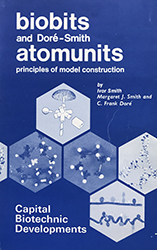 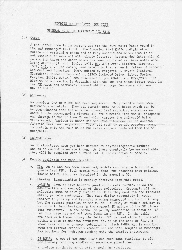 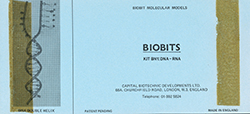 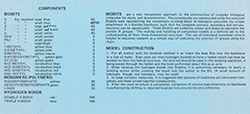 Models
for Macromolecules, Nucleic Acids and Proteins
by Ivor Smith, Margaret J. Smith and C. F. Doré. Forms
Chapter 16 of Chromatographic and Electrophoretic
Techniques, pub. W. Heinemann 1976, pp. 409 -
453. An extensive heavily illustrated chapter
describing the potential of this model type. Supplied
as a separate booklet with the kits. Link is to
archive.org free to borrow book with an account. Models
for Macromolecules, Nucleic Acids and Proteins
by Ivor Smith, Margaret J. Smith and C. F. Doré. Forms
Chapter 16 of Chromatographic and Electrophoretic
Techniques, pub. W. Heinemann 1976, pp. 409 -
453. An extensive heavily illustrated chapter
describing the potential of this model type. Supplied
as a separate booklet with the kits. Link is to
archive.org free to borrow book with an account.
Biobits Nucleic Acid (BN) General
Notes to Accompany all Kits. A five page typed
A4 supplement was also included in my own purchased
outfit.
|
Catalin Ionic
|
Maker / designer
|
Needs Plastics Ld, Middlesex, UK. The
company still exists with a website and makes custom plastic
items.
|
|
Type
|
Ionic
|
|
Materials
|
Catalin, a brand name for a
phenol-formaldehyde plastic, see Wikipedia entry for 'Catalin'. Anions translucent,
cations opaque.
The drilled ions sit on
vertical brass rods supported on horizontal brass bars
mounted on a square plastic base. Cut to length
plastic tubing separates ions on rods when required.
|
|
Presentation
|
Wooden box with compartments.
|
|
Scale
|
10 mm = 0.1 nm
|
|
|
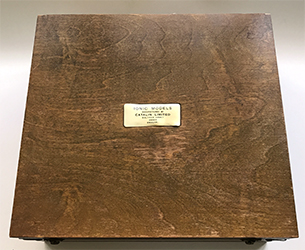 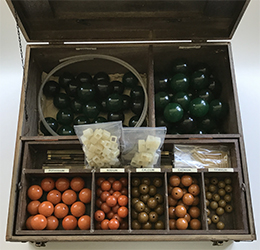  |
|
|
|
|
Documents:
|
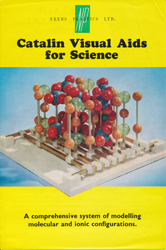 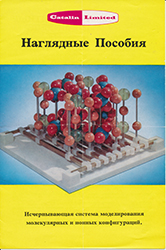 Catalin
Visual Aids for Science (English and Russian
versions*). Covers both the molecular and ionic
model systems. Catalin
Visual Aids for Science (English and Russian
versions*). Covers both the molecular and ionic
model systems.
(*Acknowledgement.
Thank you to Bill an eBay UK seller ID
'chemistry63hg' now 'Neutrino Positive' who sold me
my example. A fellow passionate collector of vintage
models who loaned these original documents to scan
from the second kit he possessed.)
|
Catalin Molecular
|
Maker / designer
|
Needs Plastics Ld, Middlesex, UK. The
company still exists with a website and makes custom plastic
items.
|
|
Type
|
Covalent, space filling
|
|
Materials
|
Catalin, a brand name for a
phenol-formaldehyde plastic, see Wikipedia entry for 'Catalin'. Anions translucent,
cations opaque.
|
|
Presentation
|
Wooden box with compartments.
|
|
Scale
|
10 mm = 0.1 nm
|
|
|
  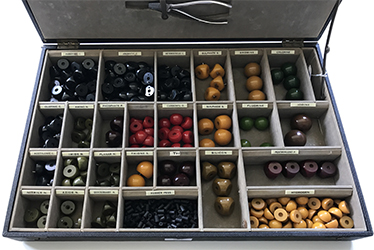
|
|
|
|
|
Documents:
|
  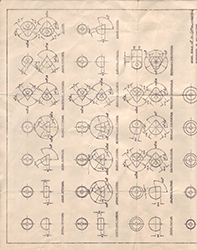 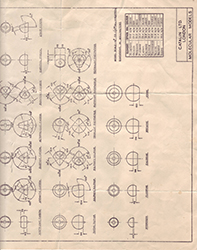 Catalin Visual Aids for Science
(English and Russian versions*). Covers both the molecular and ionic
model systems. Catalin Visual Aids for Science
(English and Russian versions*). Covers both the molecular and ionic
model systems.
Catalin technical drawing of
the atom designs. Large sheet split between two A4
scans
(*Acknowledgement.
Thank you to Bill an eBay UK seller ID
'chemistry63hg' now 'Neutrino Positive' who sold me
my example. A fellow passionate collector of vintage
models who loaned these original documents to scan
from the second kit he possessed.)
|
Courtauld
|
Maker / Designer
|
Dr. G. S. Hartley of Courtaulds Ltd. /
Supplied by Griffin & George Ltd., Wembley,
Middlesex, UK. The latter a major laboratory supplier
of the time.
|
|
Type
|
Covalent space filling
|
|
Materials
|
Plastic with proprietary brass links in
rubber collars to fit into spring loaded mounts in the
atoms.
|
|
Presentation
|
Wooden box with compartments.
|
|
Scale
|
0.8 inch (20.3 mm) = 0.1 nm
|
|
|
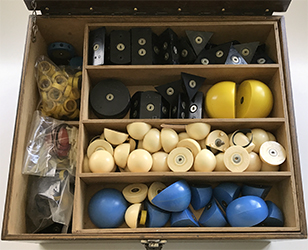  
|
|
|
|
|
Documents:
|
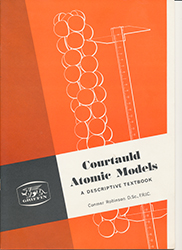 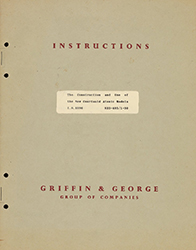 Courtauld
Atomic Models. My copy* of a later part colour edition. Courtauld
Atomic Models. My copy* of a later part colour edition.
The
Construction and Use of the New Courtauld Atomic
Models.
Dated 1966. 'I.S. 1096' 'S33-405/1-50'. Published
by Griffin and George Ltd. The earlier original 1962
edition (right) in monochrome hosted by the Science
History Institute Museum and Library, Philadelphia.
Free to download as a pdf. Reduced page image from
museum website,
click image to visit the site.
*Acknowledgement.
My boxed set did not have a copy. An eBay seller
'gerharja-0' was selling a boxed outfit with two
copies of the manual. He generously split a copy and
sold separately to me.
|
Ealing CPK (Corey - Pauling - Koltun)
|
Maker / Designer
|
Ealing, Cambridge, Massachusetts, USA.
/ 'Sub-committee of the U.S National Institutes of
Health' (Walton, p.41)
|
|
Type
|
Space filling
|
|
Materials
|
Hollow coloured plastic
|
|
Presentation
|
Compartmentalised box?
|
|
Scale
|
12.5 mm = 0.1 nm
|
|
|
Kit images - (The author does not
currently own an example of this set.)
|
|
|
|
|
Documents:
|
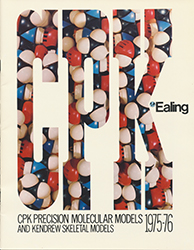 CPK
Precision Molecular models and Kendrew Skeletal
Models 1975-76. Extensive colour, heavily
illustrated booklet on the system, 32 pages. CPK
Precision Molecular models and Kendrew Skeletal
Models 1975-76. Extensive colour, heavily
illustrated booklet on the system, 32 pages.
See references on the Wikipedia 'Space-filling model' page to
papers by the designers.
Also see the Wikipedia 'CPK colouring' entry which
describes the history of the now widely adopted
colouring convention of elements.
|
Fisher-Hirschfeld-Taylor (FHT)
|
Maker / Designer
|
Fisher Scientific Co, USA. A long established from the 1880s laboratory supplier and of scientific
apparatus. See the history on the company's current
website.
|
|
Type
|
Space filling
|
|
Materials
|
Coloured hollow plastic atoms with 'press stud' style metal bond fastenings.
|
|
Presentation
|
Wooden box with compartments.
|
|
Scale
|
10 mm = 0.1 nm
|
|
|

|
|
|
|
|
Documents:
|
 Two page scan pp. 840-841 from 'Fisher Scientific Co Catalogue 77', dated 1977? (Open access on www.archive.org.) Two page scan pp. 840-841 from 'Fisher Scientific Co Catalogue 77', dated 1977? (Open access on www.archive.org.)
Kit image above temporary from my recent eBay purchase pending receipt.
|
Gallenkamp
|
Maker / Designer
|
Gallenkamp, UK. A long established from
the 1880s laboratory supplier and of scientific
apparatus. See the history on the company's current
website.
|
|
Type
|
Ball and spoke
|
|
Materials
|
Coloured plastic balls with drilled
holes for multiple valencies. Steel spring bonds.
|
|
Presentation
|
Cabinet with drawers for largest set,
plastic boxes for smaller sets (see catalogue scan
below).
|
|
Scale
|
35 mm = 0.1 nm (to atom centres)
|
|
|
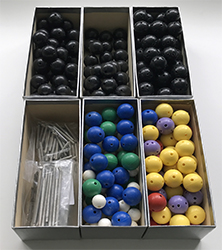
|
|
|
|
|
Documents:
|
 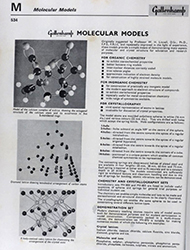 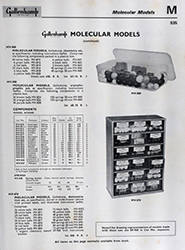 Instructions.
Molecular Models MV-800, 805 and 870. Issue 7. Undated ca. 1950s? 11 pages,
7 figs. Instructions.
Molecular Models MV-800, 805 and 870. Issue 7. Undated ca. 1950s? 11 pages,
7 figs.
Gallenkamp catalogue 16th edition, catalogue entry
pp.534-535. (Open access on www.archive.org.)
|
Cochranes of Oxford. Orbit Open University
|
Maker / Designer
|
Cochranes of Oxford Ltd. Orbit remains
a current model system but the OU version contents and
booklet was aimed at the Open University courses
around 2006.
|
|
Type
|
Skeletal
|
|
Materials
|
Plastic 'atom centres' with valence
prongs, plastic straws of appropriate length, precut
or cut to suit.
|
|
Presentation
|
Flat card box with plastic inlay of
compartments.
|
|
Scale
|
3 cm = 0.1 nm
|
|
|
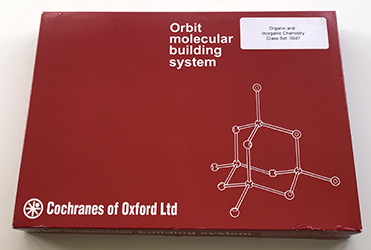 
|
|
|
|
|
Documents:
|
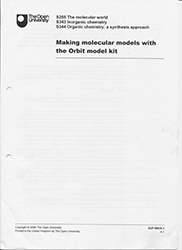 Making molecular models with
the Orbit model kit. Making molecular models with
the Orbit model kit.
The Open University:
S205 The molecular world, S343 Inorganic chemistry,
S344 Organic chemistry: a synthesis approach.
Dated 2006, a six page illustrated
booklet.
|
Sargent
|
Maker / Designer
|
E H Sargent & Co., Chicago. The
company was established in 1852 with a long history in supplying laboratory
and scientific equipment, after a merger in 1968
becoming the Sargent-Welch Scientific Company. The
link is to the current Sargent-Welch website.
|
|
Type
|
Ball and spoke
|
|
Materials
|
Painted wooden balls with slotted
wooden pegs and springs.
|
|
Presentation
|
Cardboard box with compartments.
|
|
Scale
|
C & N atoms 11⁄4 inch diameter, others 11⁄8 th inch diameter.
|
|
|
 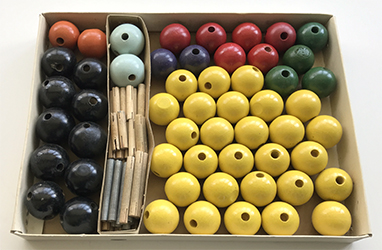
|
|
|
|
|
Documents:
|
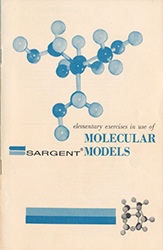 Elementary
exercises in use of Molecular Models. Undated 7 page illustrated booklet. Elementary
exercises in use of Molecular Models. Undated 7 page illustrated booklet.
The booklet notes that it was '"Derived
from "Molecular Models in the Elementary Organic
Laboratory" by Wallace R. Brode and Cecil E. Boord,
Journal of Chemical Education, 9,1774, (1932).' (Open
Access on the archive.org site.)
|
Books
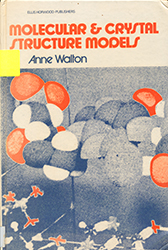 Molecular and Crystal Structure Models by Anne Walton, pub. 1978 by Ellis Horwood
Ltd., 201 pp.
Molecular and Crystal Structure Models by Anne Walton, pub. 1978 by Ellis Horwood
Ltd., 201 pp.
This is the key resource on models by
all the key makers, written in 1978 when physical models still
dominated with wide access to computer modelling software some
decades away. At the time of writing two copies are available
on AbeBooks starting below £10. The passion of the writer
for her subject shines through and a good read.
The publisher's note on the author is quoted as follows.
Dr. Anne Walton is Senior Lecturer in
Chemistry at Westfield College, University of London. She
joined the College initially in 1961 from the University
of Aberdeen, where she had been Assistant in Chemistry.
Dr. Walton gained her B.Sc. and Ph.D. in Chemistry from
the University of Nottingham in 1957 and 1960
respectively.
Her pre-university career began in 1948, when she joined
the Research Association, British Rubber Manufacturers as
a laboratory assistant. From 1952 to 1954 she was
laboratory assistant at Beckenham County Grammar School
for Girls, Kent, simultaneously studying part-time at
Croydon and Norwood Polytechnics for her university
entrance qualifications.
The author is highly-esteemed in the field of molecular
and crystal structure models, having lectured and
demonstrated on models and their applications at the
Universities of Loughborough, Nottingham, East Anglia and
the University of London Institute of Education, and
mounted full-scale exhibitions at Westfield College and at
the University of Sheffield for The Chemical Society
Autumn Meetings, 1976. James Gillison's cover design shows
a guanine-cystosine base pair model.
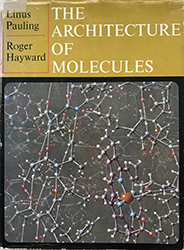
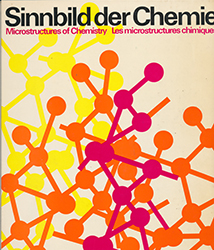
The Architecture of Molecules by Linus Pauling and Roger Hayward, pub. 1964
by Freeman, 117pp.
An author who needs no introduction. A superb
book aimed at the general audience celebrating the variety of
chemical structures. Full page artwork by Hayward with
opposite page text by Pauling. Copies currently available on AbeBooks starting below £10, also often eBay.
Sinnbild der Chemie, Microstructures of
Chemistry, Les microstructures chimiques by Herbert W Franke, pub. 1967 by Basilius
Presse AG, 148pp.
This is a splendid celebration of chemical
structures with an extensive introduction in German followed
by full page illustrations of structures using both physical
and computer methods. The image captions are in English and
French as well as German.
Phone app software such as Yandex Translate is
very useful to translate to screen part pages to read quite
comfortably. Two copies currently on AbeBooks from £23.
Other Micscape resources
I've attempted a review for five of the main
molecular models systems presently available.
A comparative review
of five brands of molecular model kits. With notes on the
educational merits of kits in an age of software. - compares five current major brands
(ChemKits, Minit, Molecular Visions (Darling Models),
Molymod, Orbit)
with 'Molecules in the News' in
Spring 2017 supplement (heptacene, triangulene and a
molecular
machine (a molecular ratchet). PDFs Apr.17
Combining my interest in stamps some past
articles present models of molecules from Nature both goodies
and nasties. See Micscape Lite
section.
Selection of online resources
Whipple Museum of the History of Science
(Cambridge, UK) Types of Molecular Models. Describes the basic types with examples from
their collection.
Wikipedia 'Molecular model' entry. A short history with discussion of
types, Further Reading and links to online resources.
The History of Molecular Models link in the
Wikipedia entry above is to an illustrated 2004 paper entitled
'Visualizing the Unseen' by W. Gerhard Pohl. This is a new
reference to the author and a good read. (Link is to a
Wayback Machine mirror, the conference website it was
presented at no longer exists.)
History of Visualization of Biological
Macromolecules by Eric Martz and Francoeur. Extensive
website resource. Includes both physical and computer model
approaches.
Comments to the author David
Walker are welcomed.
Published
in the November 2024 edition of Micscape.
Please
report any errors to the Micscape Magazine Editor via the
contact on current magazine index.
Micscape
Magazine is the free monthly web magazine of Microscopy-UK.
©
Onview.net Ltd, Microscopy-UK, and all contributors 1995
onwards. All rights
reserved.


































 Molecular and Crystal Structure Models by Anne Walton, pub. 1978 by Ellis Horwood
Ltd., 201 pp.
Molecular and Crystal Structure Models by Anne Walton, pub. 1978 by Ellis Horwood
Ltd., 201 pp.
